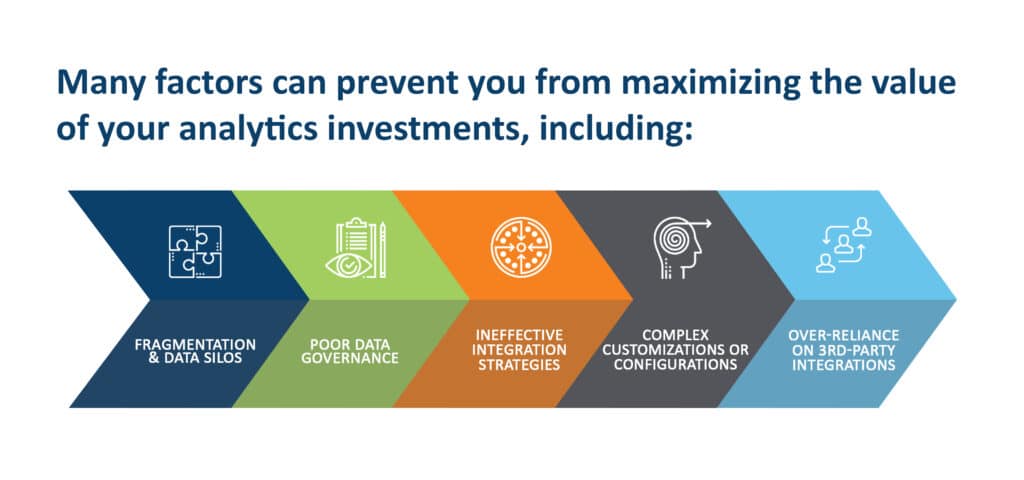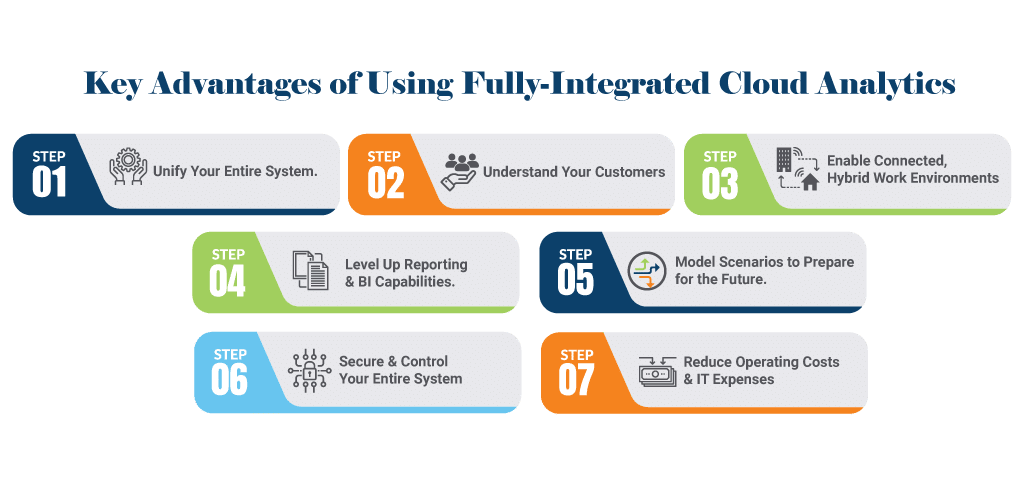What is the Advantage of Using a Fully-Integrated Cloud-Based Data Analytics Platform?
Learn what the advantages of a fully-integrated cloud-based data analytics platform are and why it's a pillar of any digital transformation.
Learn what the advantages of a fully-integrated cloud-based data analytics platform are and why it's a pillar of any digital transformation.
Table of Content
This idea that big data and cloud-based analytics have the power to transform entire organizations–and industries–is old news.
Today, most companies run several cloud-based analytics solutions to understand their customers, run marketing campaigns, and improve everything from sales tactics to production processes.
But for many orgs, there’s still a gap between implementing cloud analytics and leveraging them to achieve strategic goals.
Transitioning data and analytics tools to the cloud alone doesn’t make it easy to access, share, or operationalize those insights.
As it turns out, “unlocking the hidden value” of your data is extremely hard without total integration.
Below, we’ll explain what a fully-integrated data analytics platform is and why it’s a pillar of any digital transformation journey.
A fully integrated cloud analytics platform is an end-to-end solution that combines analytics, BI, performance insights, and into a single platform.
Integrated cloud platforms have more influence on your data strategy than you might realize.
But— it makes a lot more sense if you consider the forces shaping the current business landscape.
The explosion of big data. Increased access to AI/ML technologies. Rising customer expectations. Privacy and security challenges. And then there’s the crushing pressure to become the data-driven, agile business of the future — or die within the next few years.

Organizations (and providers) are realizing that creating a hyper-connected business in the cloud is essential when it comes to overcoming their biggest challenges — whether we’re talking infrastructure and silos or COVID and data-savvy competitors.
At the end of 2020, Forrester predicted that organizations would embrace “innovation through ecosystems” with data-driven practices embedded across the entire organization.
Analysts were spot-on. This year, there’s more emphasis on improving business agility and resilience. Which, in turn, underscores the fact that integrated analytics are already a critical priority.
You need real-time access to all business data. You need self-service reporting tools – embedded with AI-driven guidance and wisdom. You also need high degrees of automation, speed, and intelligence across the entire organization.
But–none of this is possible without a fully-integrated cloud infrastructure as your foundation.

Cloud-based BI and analytics offer a long list of benefits to all businesses, regardless of size, sector, or what they sell.
That said, here’s a look at some of the “big ones:”
Fully-integrated cloud analytics platforms pull data from all connected sources, unifying them in one central repository.
This brings insights into existing applications, tools, and services. And–it allows users to use those insights to create new products/services, retool existing workflows, and tear down the silos from old, fragmented solutions. Organizations can track resource utilization, monitor business processes across multiple job sites and warehouses, improve sales strategies, and more.
Today, brands are expected to keep up with customers’ ever-changing needs — delivering products/services that speak to where they are right now or better yet — where they’ll be in the near future.
There’s also increased pressure to deliver personalized engagement — in near real-time — without crossing the invisible line where the personal becomes, well, creepy.
According to Forrester’s 2022 Predictions forecast, most brands fall short. 75% of personalized engagement strategies fail to meet ROI goals.
Integrated data analytics platforms (like D365 Customer Insights) help organizations understand customers by presenting the full picture. Everyone — whether they’re on the production floor or on the front-line with customers works from the same data set and speaks a common language. This helps teams can ID and fix problems faster, refine messaging & content, and develop products based on real user feedback.
Cloud solutions are “always on,” enabling faster collaboration and easier sharing. Data sharing needs to be easy. Employees must be able to collaborate in real-time – without switching between apps or emailing multiple versions of the same document back and forth. We’re seeing more solutions that focus on building these hyper-connected digital work environments.
Just look at the latest updates to Microsoft Teams. You can bring workflows and data from other apps into Teams. Tighter integration with the Power Platform and D365 means users find and share files directly inside the chat. They can run virtual events – and capture data from attendees that can be used for marketing campaigns, analysis, etc. What’s more, users can build custom apps and virtual assistants to automate manual processes.
Splunk’s 2021 State of Observability report calls observability “body armor for the business.” It’s critical for identifying root causes, fixing problems as they happen, and responding to changes in real-time. Fully integrated cloud-based analytics and BI solutions allow users to view all critical data from one dashboard. Done right, dashboards and reports should be tailored to the individual user. That way, they can focus on the data most relevant to their role — in context with the bigger picture.
You may not be able to predict the future but today’s predictive modeling technology allows you to explore countless “what-if” scenarios – and the various paths to success based on different conditions. This is big for resiliency and agility – giving businesses critical information about its future options.
In a cloud environment, data can be verified and tracked, formulas can be preserved, and audit trails can be recorded and maintained automatically.
Tighter integration makes it easier to control your data, maintain compliance, and protect your business and customers from cyber threats. Essentially, it makes it easier to ensure that bad actors don’t slip through the cracks and that reports, documents, and processes remain intact–and compliant. Additionally, if you’re using Dynamics 365 Finance, you can set rules that automatically update your system when regulatory requirements change.
In general, cloud-based solutions cost less than traditional, on-prem solutions. There’s no hardware to maintain, no expensive software licenses, and your provider deals with storage, security, and updates. With a fully-integrated cloud analytics platform, you’re able to take things a few steps further.
For example, organizations can capture data from specific tasks or entire processes – AI/ML uses that data to surface improvement opportunities they likely would never discover on their own. Naturally, these capabilities help orgs reduce waste and prevent machines from breaking down. But–they also allow them to become proactive about making improvements that create value.
Cloud-based analytics unlock countless business benefits for any organization.
We’re talking greater agility, better decision-making, a deeper understanding of customers, cost-savings, disaster recovery, and more.
That said, the key takeaway here is that investing in a fully-integrated cloud analytics platform isn’t an optional upgrade. It’s a critical steppingstone toward becoming the kind of resilient, agile, data-driven business that will not only survive the 2020s – but thrive in decades to come.
To learn more about the advantages of using a fully integrated cloud-based data platform, reach out to Velosio today!